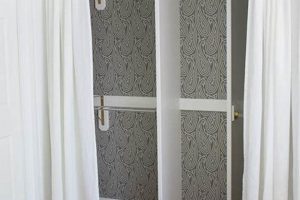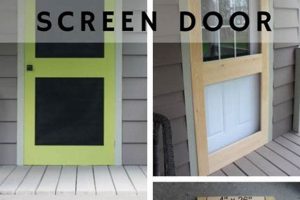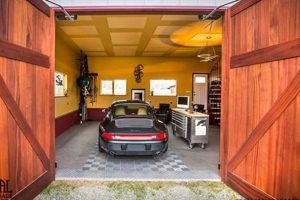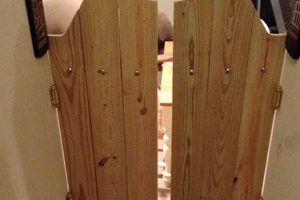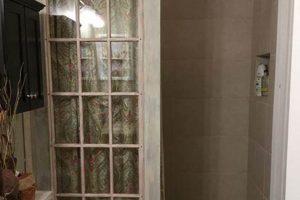Creating customized fronts for cabinetry allows homeowners to personalize their living spaces. This endeavor encompasses a range of approaches, from simple refinishing to complete replacement with handcrafted components. For example, a homeowner might choose to apply a fresh coat of paint and new hardware to existing doors, or alternatively, construct entirely new doors from raw lumber according to a specific design.
Undertaking such projects offers several advantages. It provides a cost-effective method for updating the appearance of kitchens, bathrooms, or other areas with built-in storage. Moreover, it enables the expression of individual style and creativity, resulting in a unique aesthetic that reflects personal preferences. Historically, homeowners have often modified or built their own cabinetry to adapt to changing needs and design trends, reflecting a tradition of resourcefulness and self-sufficiency.
The following sections will explore specific techniques, material choices, and design considerations relevant to achieving successful and aesthetically pleasing results in cabinet door refurbishment or construction. These elements are critical to consider before embarking on such a project.
Essential Considerations for Cabinet Door Customization
Achieving a professional finish in cabinet door modification or creation requires careful planning and execution. The following guidelines address critical aspects of the process, ensuring durable and aesthetically pleasing results.
Tip 1: Precise Measurement is Paramount: Prior to material selection or cutting, accurate measurements of existing cabinet openings are essential. Deviations can lead to ill-fitting doors and functional issues. Double-checking dimensions minimizes errors.
Tip 2: Material Selection Impacts Durability: The choice of wood or other material significantly affects the longevity and appearance of the finished product. Solid hardwoods, while more expensive, offer superior resistance to warping and wear compared to lower-cost alternatives like MDF.
Tip 3: Surface Preparation is Critical for Adhesion: Prior to painting or staining, thorough sanding and priming are crucial for proper adhesion and a smooth, uniform finish. Neglecting this step can result in peeling or uneven color application.
Tip 4: Hardware Selection Affects Functionality and Aesthetics: Hinges, knobs, and pulls should be chosen based on both their functional suitability and their contribution to the overall design aesthetic. Ensure hardware is compatible with the door’s thickness and weight.
Tip 5: Consider Edge Treatments for a Professional Look: Edge banding or routing can enhance the visual appeal and durability of cabinet doors. Applying edge banding to MDF doors protects the edges from moisture and impact damage.
Tip 6: Secure and Accurate Assembly is Vital: When constructing doors from multiple pieces, ensure joints are securely fastened using appropriate adhesives and fasteners. Clamping during glue drying is essential for strong and aligned joints.
Tip 7: Multi-Coat Finish Application Improves Longevity: Applying multiple thin coats of paint or varnish, with adequate drying time between each coat, provides a more durable and aesthetically pleasing finish than a single thick coat.
Adhering to these guidelines helps to ensure the creation of cabinet doors that are both visually appealing and functionally sound, enhancing the value and enjoyment of the living space.
The next section will address frequently asked questions related to this home improvement project.
1. Material Durability
Material durability constitutes a foundational element in the successful implementation of cabinet door customization projects. The inherent properties of chosen materials directly influence the longevity, stability, and resistance to wear and tear of the finished product. Selection should be carefully considered to align with anticipated usage and environmental conditions.
- Wood Species Selection
The choice of wood species significantly impacts the durability of cabinet doors. Hardwoods like oak, maple, and cherry offer superior resistance to dents and scratches compared to softwoods like pine. This distinction is critical in high-use areas such as kitchens, where doors are subjected to frequent handling and potential impacts. Failure to select a sufficiently durable wood can result in premature wear and a diminished aesthetic over time.
- Engineered Wood Composites
Materials such as MDF (Medium-Density Fiberboard) and plywood provide alternative options. While often more cost-effective than solid wood, their durability depends on construction and finishing techniques. MDF is susceptible to moisture damage, while plywood’s resistance is determined by the quality of the veneer and adhesives used. Protective coatings and edge banding are essential to enhance the longevity of these materials in cabinet door applications.
- Moisture Resistance
Humidity fluctuations can significantly impact the structural integrity of cabinet doors. Materials prone to warping or swelling in response to moisture require careful consideration. Applying moisture-resistant finishes and employing construction methods that minimize expansion and contraction are crucial, especially in damp environments like bathrooms. Failure to address moisture resistance can lead to door misalignment and functional impairments.
- Impact and Scratch Resistance
The ability of a cabinet door to withstand impacts and scratches directly affects its long-term appearance. Durable finishes, such as catalyzed varnishes or powder coatings, can enhance resistance to surface damage. Selecting materials with inherent hardness, like certain hardwoods or high-pressure laminates, also contributes to improved durability in high-traffic areas.
The interplay between material selection, appropriate finishes, and sound construction practices ultimately determines the durability of customized cabinet doors. Prioritizing material durability ensures that the investment in time and resources yields a long-lasting and aesthetically pleasing addition to the living space, thus enhancing the overall home value.
2. Design Style
Design style functions as a primary driver for initiatives centered on crafting or modifying cabinet doors. The chosen aesthetic dictates not only the visual appearance of the cabinetry but also influences material selection, construction techniques, and hardware choices. For example, a Shaker-style door, characterized by its simple, clean lines and recessed panel, necessitates a different construction approach compared to a raised-panel door associated with more traditional designs. The former often involves basic joinery and readily available materials, while the latter may require specialized tools and woodworking skills. A mismatch between the desired design style and the capabilities of the individual undertaking the project, or the resources available, can result in a compromised outcome. Moreover, consistency in design style is crucial for maintaining a cohesive visual narrative throughout the space.
The impact of design style extends beyond mere aesthetics. The selection of a particular style can influence the perceived value and functionality of the cabinetry. Contemporary, minimalist designs often prioritize clean surfaces and concealed hardware, impacting the storage capacity and accessibility of the cabinets. Conversely, more elaborate designs may incorporate decorative elements that enhance visual appeal but potentially compromise ease of cleaning or maintenance. Real-life examples of design style influencing cabinet door modifications abound. A homeowner seeking to update a dated kitchen may opt for a contemporary, flat-panel door style to achieve a modern aesthetic, while another might choose a classic raised-panel design to maintain the traditional character of their home.
In summary, design style constitutes an indispensable element in the realm of DIY cabinet door modifications. It functions as a blueprint guiding the entire process, from initial planning to final execution. Understanding the implications of different design styles, and aligning them with individual skills, resources, and the overall aesthetic goals, is paramount for achieving successful and visually harmonious results. A failure to adequately consider design style can lead to functional compromises or a disjointed appearance, diminishing the value and impact of the project.
3. Hardware Selection
The selection of appropriate hardware represents a critical decision point in the context of creating custom cabinet doors. It transcends mere aesthetic considerations, influencing both the functionality and longevity of the finished product. Careful consideration of various factors is essential for optimal outcomes.
- Hinge Type and Load Capacity
Hinges are foundational components for door functionality. The selected type, whether concealed, surface-mounted, or soft-close, must be appropriate for the door’s weight and size. Overloading hinges can lead to premature failure, door misalignment, and compromised operation. For instance, heavier solid wood doors necessitate robust hinges with a high load capacity, while lighter MDF doors can utilize less substantial options. Utilizing the incorrect hinge type results in door instability and reduced lifespan.
- Knobs and Pulls: Ergonomics and Style
Knobs and pulls serve as the primary interface between the user and the cabinet. Their design should align with the overall aesthetic while prioritizing ergonomic considerations. Small, hard-to-grasp knobs on frequently used cabinets can lead to user frustration. The finish and material should also be resistant to wear and corrosion. A mismatch between the hardware style and the overall cabinet door design can detract from the visual appeal of the finished product, thus the need to thoughtfully assess design options and user experience.
- Material Compatibility and Corrosion Resistance
The material composition of hardware should be compatible with the environment in which the cabinets are installed. In damp environments, such as bathrooms or kitchens, stainless steel or corrosion-resistant finishes are essential to prevent rust and degradation. Using inappropriate materials in such conditions can lead to hardware failure and necessitate costly replacements. Abrasive cleaning products can also damage finishes, reducing the lifespan.
- Mounting Considerations and Alignment
Proper mounting and alignment of hardware are crucial for smooth and reliable door operation. Misaligned hinges or improperly installed knobs can cause binding, sticking, and premature wear. Utilizing jigs and templates during installation ensures accuracy and consistency. Furthermore, selecting hardware with adjustable features allows for fine-tuning door alignment after installation. Attention to detail during the installation process is necessary to achieve a professional finish and optimal functionality.
Ultimately, the selection of hardware is an integrated part of the design and construction process. A systematic approach, encompassing considerations of functionality, durability, ergonomics, and aesthetics, contributes significantly to the success of custom cabinet door projects. These components tie together to complete the overall vision.
4. Finishing Techniques
Finishing techniques are inextricably linked to successful cabinet door customization projects. The quality and appropriateness of the finish directly impact the aesthetic appeal, durability, and long-term performance of customized cabinet doors. Neglecting proper finishing procedures can negate the benefits of careful material selection and precise construction, leading to premature wear, unsightly blemishes, and ultimately, the need for replacement. For example, a meticulously crafted solid wood door, lacking a suitable protective finish, becomes vulnerable to moisture damage, scratches, and fading, significantly reducing its lifespan. Consequently, understanding and applying appropriate finishing techniques is indispensable for realizing the full potential of cabinet door creation projects.
Different design styles and materials necessitate specific finishing approaches. Painted finishes, commonly employed on MDF or paint-grade hardwoods, require meticulous surface preparation, including priming and sanding, to achieve a smooth, uniform appearance. Stain finishes, often favored for showcasing the natural grain of wood, demand careful selection of wood species and stain formulations to achieve the desired color and depth. Furthermore, the choice of topcoat, whether varnish, lacquer, or polyurethane, influences the finish’s resistance to scratches, chemicals, and UV light. Consider the finishing process for a high-end DIY project that calls for distressed kitchen cabinets. An aged appearance with subtle imperfections is desirable. The finishing process may consist of multiple steps: base coat, glazing, dry brush, and top coat, each applied and removed partially to achieve an authentic and aesthetically pleasing distressed look.
The correlation between appropriate finishing techniques and project longevity is evident. The application of multiple coats of a durable topcoat, coupled with proper curing time, provides a robust barrier against environmental factors and daily wear. Conversely, a poorly applied or inadequate finish compromises the structural integrity and visual appeal of the cabinet doors, leading to costly repairs or replacements. Recognizing the criticality of finishing techniques elevates such home improvement projects from merely functional to aesthetically enduring and increases overall property value.
5. Measurement Precision
In projects involving cabinet door customization, measurement precision directly dictates the success or failure of the undertaking. Inaccurate measurements, even minor discrepancies, cascade into a series of complications, ranging from ill-fitting doors to compromised functionality and aesthetic inconsistencies. The cause-and-effect relationship is straightforward: imprecise measurements lead to incorrectly sized components, resulting in doors that either fail to properly close, create unsightly gaps, or require extensive modifications to achieve a functional fit. For example, if the width of a cabinet door is measured even a quarter-inch too short, a noticeable gap will be present along the side, detracting from the visual appeal and potentially allowing dust or pests to enter the cabinet. The opposite scenario, where a door is measured too wide, can prevent proper closure or require trimming, which often compromises the integrity of the door’s construction and finish.
The significance of measurement precision extends beyond mere dimensions. It encompasses the angles, squareness, and alignment of all components involved in the cabinet door. An out-of-square door, even if dimensionally accurate, will exhibit uneven gaps and may strain the hinges, leading to premature wear and potential failure. Precise measurements are also crucial for hardware placement, such as hinges and pulls. Inconsistent hardware placement not only looks unprofessional but can also affect the door’s ease of operation and overall stability. Real-life examples abound in DIY forums and home improvement blogs, where frustrated individuals recount struggles stemming from measurement errors. These errors often necessitate costly remakes or time-consuming adjustments, highlighting the practical significance of prioritizing measurement accuracy from the outset.
To summarize, measurement precision constitutes a non-negotiable element in the successful implementation of projects focused on creating custom cabinet doors. It acts as a foundational prerequisite, influencing the fit, function, and aesthetic appeal of the finished product. While challenges may arise in achieving absolute accuracy, employing appropriate measuring tools, verifying measurements multiple times, and accounting for potential variations in materials are essential strategies for mitigating errors and ensuring a positive outcome. Overlooking measurement precision translates directly into increased material costs, wasted time, and ultimately, a less-than-satisfactory result, underscoring the importance of meticulous attention to detail throughout the entire process.
6. Cost Efficiency
Cost efficiency represents a central consideration in the execution of do-it-yourself cabinet door projects. The ability to achieve desired aesthetic and functional improvements while minimizing expenditure is a primary driver for many homeowners choosing the DIY approach. A comprehensive understanding of cost-saving strategies is therefore essential for maximizing the value derived from such endeavors.
- Material Sourcing and Selection
The source and type of materials significantly impact project costs. Purchasing lumber directly from sawmills or utilizing reclaimed wood can offer substantial savings compared to retail outlets. Opting for less expensive, paint-grade hardwoods or engineered wood products like MDF, where appropriate, can also reduce material expenses without necessarily compromising the final aesthetic. However, careful consideration must be given to the long-term durability and suitability of these alternative materials to avoid future replacement costs. Example: A homeowner builds cabinet doors from repurposed shipping pallets. The materials are essentially free, but extensive labor is required to disassemble, clean, and prepare the wood for use. A balance is struck between material cost and labor investment.
- Tool Investment vs. Rental
Specialized tools are often required for constructing cabinet doors, such as routers, table saws, and jointers. The decision to purchase or rent these tools depends on the frequency of use and the project’s complexity. Renting tools for a single project can be more cost-effective than purchasing them outright, particularly for expensive, infrequently used equipment. However, for individuals planning multiple DIY projects, investing in quality tools may prove more economical in the long run. Example: A homeowner needs to route decorative edges on cabinet doors. Renting a router and bits for a weekend project is cheaper than buying a router, especially considering storage space limitations.
- Labor Costs and Time Investment
While DIY projects eliminate direct labor costs, the time invested in design, construction, and finishing represents a significant opportunity cost. Accurately assessing the time required and the value of that time is crucial for determining the true cost efficiency of the project. Overestimating one’s skills or underestimating the time commitment can lead to delays, rework, and ultimately, increased overall costs. Example: A homeowner decides to build and install custom cabinet doors during their vacation time. If the project takes longer than anticipated, it might encroach on other planned activities or necessitate taking time off from work, effectively increasing the overall project cost.
- Finishing Materials and Techniques
The choice of finishing materials, such as paints, stains, and varnishes, can also significantly impact project expenses. Selecting cost-effective yet durable finishing products is essential for balancing aesthetic goals with budgetary constraints. Furthermore, employing efficient application techniques, such as using spray equipment instead of brushes, can minimize material waste and reduce labor time. Example: A homeowner chooses to stain cabinet doors instead of painting them, which can save on primer costs. However, stain requires careful surface preparation and multiple coats to achieve a consistent finish, potentially offsetting some of the initial savings. This underscores the importance of considering the total cost of the finishing process.
In conclusion, achieving cost efficiency in DIY cabinet door projects requires a holistic approach that considers material sourcing, tool utilization, labor investment, and finishing techniques. A careful assessment of trade-offs between upfront costs, long-term durability, and personal capabilities is essential for maximizing the return on investment and realizing the desired aesthetic improvements within budgetary constraints. A well-executed and cost-conscious approach ensures the final result is more than just aesthetically pleasingit reflects a judicious allocation of resources, resulting in a valuable home upgrade.
Frequently Asked Questions
The following section addresses common inquiries pertaining to the creation of customized fronts for cabinetry. The information provided aims to clarify misconceptions and offer practical guidance for successful project completion.
Question 1: What is the most cost-effective material for constructing cabinet doors?
Medium-density fiberboard (MDF) typically represents the most economical option. However, its susceptibility to moisture damage necessitates careful sealing and finishing, particularly in humid environments.
Question 2: How can warping of solid wood cabinet doors be prevented?
Proper wood selection, acclimation to the environment, and the application of a consistent finish on all surfaces are crucial. Furthermore, employing construction techniques that minimize stress, such as using mortise-and-tenon joints, can mitigate warping.
Question 3: What type of finish provides the most durable protection for cabinet doors?
Catalyzed varnish or lacquer offers excellent resistance to scratches, chemicals, and moisture. However, application requires specialized equipment and proper ventilation due to the fumes involved.
Question 4: Is it necessary to prime cabinet doors before painting?
Priming is essential for achieving proper adhesion and a uniform finish. Primer seals the surface, prevents the paint from being absorbed unevenly, and provides a consistent base color.
Question 5: How can a professional-looking paint finish be achieved without using a spray gun?
Using high-quality brushes or rollers designed for smooth finishes, applying thin coats, and lightly sanding between coats can yield satisfactory results. Patience and attention to detail are paramount.
Question 6: What is the best method for repairing scratches or dents on finished cabinet doors?
Minor scratches can be concealed with touch-up markers or wax sticks designed for furniture repair. Deeper dents may require filling with wood filler, sanding, and refinishing the affected area.
Adhering to these guidelines helps to ensure the longevity and visual appeal of modified or newly constructed cabinet doors.
The subsequent section will elaborate on potential challenges and solutions often encountered during the DIY endeavor.
Conclusion
“diy cabinet door ideas”, as explored herein, represent a significant undertaking demanding careful consideration of materials, design, and execution. Successfully navigating this process hinges on precise measurements, informed material choices, and adherence to established finishing techniques. The economic benefits associated with creating custom fronts for cabinetry are contingent upon a realistic assessment of skill levels, time commitment, and potential costs associated with materials and tools. A failure to adequately address any of these key areas can compromise the structural integrity and aesthetic appeal of the final product.
The information presented provides a framework for informed decision-making. Proceeding with cabinet door projects requires a clear understanding of the inherent challenges and a commitment to meticulous craftsmanship. The resulting improvements, achieved through diligent effort, can enhance both the functionality and value of the living space. The long-term benefits depend on the quality of execution and the suitability of the chosen techniques for the intended application.


